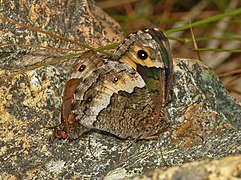Hipparchia fagi
| Hipparchia fagi | |
|---|---|

| |
| in Andorra | |

| |
| male, Republic of North Macedonia | |
| Scientific classification | |
| Kingdom: | |
| Phylum: | |
| Class: | |
| Order: | |
| Family: | |
| Genus: | Hipparchia
|
| Species: | H. fagi
|
| Binomial name | |
| Hipparchia fagi | |
| Synonyms | |
Hipparchia fagi, the woodland grayling, is a butterfly of the family Nymphalidae.[3]
Etymology[]
The Latin species name fagi, meaning of "beech" (=fagus), refers to the prevailing species of trees in the relating biotope.
Subspecies[]
- Hipparchia fagi tetrica Fruhstorfer, 1907[2]
Distribution and habitat[]
This widespread European endemic species can be found in most of Europe, mainly south of the Alps[2] (Albania; Andorra; Austria; Bosnia and Herzegovina; Bulgaria; Croatia; Czech Republic; France; Germany; Greece; Hungary; Italy; Macedonia; Montenegro; Portugal; Romania; Russia; Serbia; Slovakia; Slovenia; Spain; Switzerland; Ukraine).[4] It occurs on broad-leaved deciduous forests, coniferous woodland, grassy vegetation, in woodland glades and woodland rides and, from sea level to 1,600 m elevation.[5]
Description[]
Hipparchia fagi has a wingspan of 66–76 millimetres (2.6–3.0 in).[6] These large butterflies have dark brown uppersides of the wings, with a fringed margin, a white submarginal band more evident in the females and one black eyelet at the apex of each forewings. In the males the white band has a single very small eyelet on each hindwing, sometimes showing a white pupil, while in the females it shows one or two ocelli.[7]
The underside of the forewings is rather similar to the upperside: The hindwings are marbled of brown and white with a broad white band. The white band on the internal edge of the underside hindwings is curved, while the white band on the underside forewings is often without a significant indent.[8]
The colouration and pattern of these butterflies are an excellent camouflage on the bark of the trunks where the butterfly usually rests, with the eyespots hidden by the closed wings.[5] This species is similar but larger than Hipparchia hermione. It is also rather similar to Hipparchia syriaca and Hipparchia genava.
The caterpillar has a pale brown head with four darker streaks. Body is light brown with a bifid posterior end, a dark brown dorsal band and brownish lateral bands.[9]

female

courting - female on the left
mating - female on the right
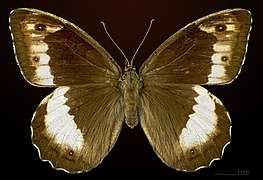
Female
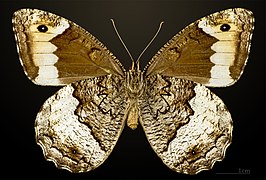
Female underside
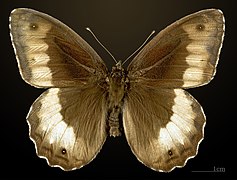
Male
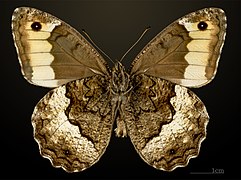
Male underside
Biology[]
Adults fly from June to September.[6] This species has one generation a year. The caterpillars overwinter. The larvae feed on various types of grass, such as Brachypodium pinnatum, Bromus erectus, Festuca rubra, Holcus lanatus and Holcus mollis.[2][5]
Bibliography[]
- Kudrna, O. (1977): A Revision of the Genus Hipparchia Fabricius. — 300 S., Faringdon – London
- Kudrna, O., Harpke, A., Lux, K., Pennerstorfer, J., Schweiger, O., Settele, J. & M. Wiemers (2011): Distribution atlas of butterflies in Europe. – 576 S.; Halle a.d. Saale
- Lionel G. Higgins et Norman D. Riley, Guide des papillons d'Europe, Delachaux et Niestlé, 1988, (Lausanne).
- Tom Tolman, Richard Lewington, Guide des papillons d'Europe et d'Afrique du Nord, Delachaux et Niestlé, (ISBN 978-2-603-01649-7).
References[]
- ^ INPN taxonomie
- ^ a b c d "Hipparchia Fabricius, 1807" at Markku Savela's Lepidoptera and Some Other Life Forms
- ^ Catalogue of life
- ^ Fauna europaea
- ^ a b c IUCN Red List
- ^ a b Simon Coombes Captain's European Butterfly Guide
- ^ Papillons du Poitou-Charentes
- ^ Euro Butterflies by Matt Rowlings
- ^ D.J. Carter et B. Hargreaves, Guide des chenilles d'Europe, Delachaux et Niestlé, 2001, ISBN 2-603-00639-8
External links[]
| Wikispecies has information related to Hipparchia fagi. |
| Wikimedia Commons has media related to Hipparchia fagi. |
- Paolo Mazzei, Daniel Morel, Raniero Panfili Moths and Butterflies of Europe and North Africa
- Larvae of North-European
- Lepiforum.de
- IUCN Red List near threatened species
- Hipparchia (butterfly)
- Butterflies described in 1763
- Butterflies of Europe
- Taxa named by Giovanni Antonio Scopoli



